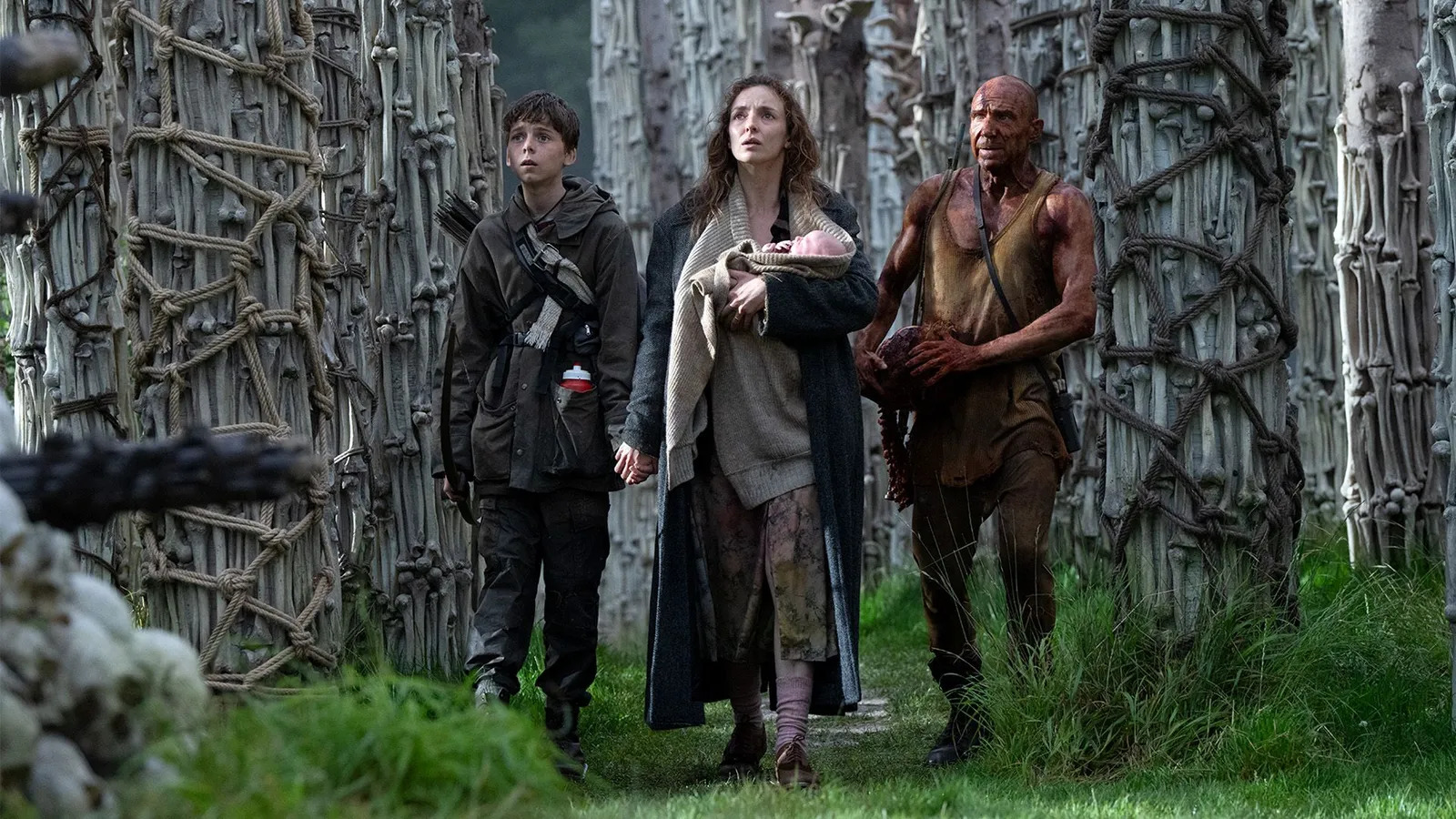PICK OF THE WEEK
28 Years Later (general release)
In their first collaboration since Sunshine (2007), director Danny Boyle and writer Alex Garland triumphantly reanimate the dormant franchise that they launched in 2002 with the classic 28 Days Later.
And no, that’s not an arch reference to the undead since, as genre pedants always rush to point out, the monsters in this particular dystopian world are not, technically, zombies at all but victims of a terrible “rage virus”. There is nothing supernatural about lab-manufactured horror.
After a bloody prologue involving the Teletubbies (I won’t spoil it) and a quick retcon of Juan Carlos Fresnadillo’s disappointing sequel 28 Weeks Later (2007) – the virus did indeed spread to the continent but was apparently “contained”– we are plunged into the life of a colony of survivors on Lindisfarne, connected to the Northumbrian mainland only by a causeway. In what amounts to an epidemiological version of Brexit, the UK is quarantined from the rest of the world; foreign naval vessels visible in the distance, preventing any continental travel by contaminated Brits.
In a blood rite of passage characteristic of pre-modern societies, 12-year-old Spike (Alfie Williams, the star of the show) is taken off the island for the first time by his father Jamie (Aaron Taylor-Johnson) to hunt the infected with bow and arrow. Even as they prepare for this initiation trial, he worries about his mother Isla (Jodie Comer) who is bed-ridden and half-demented with an undiagnosed illness.
What awaits Spike and Jamie on the other side? In the 28 years since the events of the original movie, in which Cillian Murphy’s character Jim, waking from a coma, unforgettably walked the deserted streets of London, the flesh-eaters have mutated into obese, crawling “slow-lows” who feast on worms and – more scarily – “alphas” who are stronger, faster and angrier than ever before.
The formality of the ritual is nicely captured, symbolic of a community that has embraced a mythical English past: Spike is seen off at the gate by its council of elders and warned that no rescue party will be sent if he and his father do not return.
A ragged flag of St George flies over the stockaded camp, hymns are sung in the classroom, and revellers belt out Blaydon Races and a folksy version of Tom Jones’s Delilah at the drunken feast to mark the young man’s coming of age. Here, there is a knowing nod to the cultic island madness of The Wicker Man (1973).
To compound the sense of dislocation of identity and history, Boyle also splices in images from Laurence Olivier’s Henry V (1944), blasts of infra-red footage, and audio of Taylor Holmes’ increasingly deranged recital of Rudyard Kipling’s 1903 Boer War poem “Boots”. Insanity, savagery and death lap constantly against the shores of this island refuge.
Learning that a doctor, Ian Kelson (Ralph Fiennes), may still be alive on the mainland, Spike absconds with his mother in search of a cure. This is the movie’s strongest act, dazzlingly kinetic and full of surprises – such as the arrival of a unit of shipwrecked Nato soldiers and Isla’s joy when she beholds Antony Gormley’s Angel of the North (a close counterpart to the Statue of Liberty in the original Planet of the Apes).
When they track down Kelson, slathered in orange iodine to ward off the infection, he turns out to be a benign version of Marlon Brando’s Colonel Kurtz in Apocalypse Now (1979); living amidst a vast necropolis of his own construction. This, the doctor explains to Spike, is all a necessary memento mori: “Every skull is a set of thoughts,” he says. “These sockets saw, and these jaws swallowed”. Holding one aloft, he addresses it as “Yorick”.
Thus is a strain of mysticism and religiosity imported to the saga – a theme that is also central to the movie’s cliff-hanger finale. The next instalment of a planned trilogy, 28 Years Later: The Bone Temple, directed by Nia DaCosta, has already been filmed and is set for release in early 2026. Murphy, who was executive producer this time round, is also expected to return on-screen as Jim: at which point, abnormal service will be fully restored.
THEATRE
A Moon for the Misbegotten (Almeida Theatre, London, until August 16)
“It’s the worst sort of ghost, your own,” says Josie Hogan (Ruth Wilson) to James Tyrone (Michael Shannon) – and cuts to the quick of the last play Eugene O’Neill completed.
A sequel to Long Day’s Journey Into Night (1941), written two years later, the play is performed much less frequently but has a power and tragedy all of its own. In rural Connecticut in 1923, Josie’s tenant farmer father Phil (David Threlfall, excellent) frets that Jim, a failed actor, alcoholic and “Broadway crook”, will sell the property and leave the Hogans in the lurch; he also fears for his daughter’s heart, knowing full well that she loves Tyrone dearly.
Rebecca Frecknall’s production sets the two prodigious lead actors free to explore the fierce attraction between Josie and Jim and the psychic barriers that stand between them. “Let’s sit down where the moon will be in our eyes and we’ll see romance,” she says to him.
Shannon, so often a primal, menacing force on-screen, is cadaverously fragile as Jim; yearning for the love and redemption that Josie offers but certain that he does not deserve it. Even as he stumblingly quotes Keats’ Ode to a Nightingale to her, he knows that he comes across as a phoney.
Wilson is sensational as a woman in the marchlands between solitude and the flickering hope of happiness, mounting a moonlit bid to save the man she loves from his demons. She pretends to be promiscuous and scornful by temperament, but he knows this is all a front – which makes his faltering courtship all the more painful. Their intensity together is mesmerising. One of the productions of the year.
STREAMING
Grenfell: Uncovered (Netflix)
Eight years after fire tore through Grenfell Tower in west London, killing 72 people, Olaide Sadiq’s documentary is not only a powerful account of the disaster’s terrible human cost but a chastening reminder that the bereaved families are still waiting for justice.
Interweaving the memories of survivors, relatives and first responders with shocking evidence of the personal and structural negligence that led to the blaze, Grenfell: Uncovered serves as both testimonial and indictment. Sadiq has uncovered shocking emails revealing that senior executives at Arconic, the US manufacturing corporation, had known for years how dangerously flammable the polyethylene cladding panels used at the tower were – but said and did nothing.
As the horrors of the early hours of June 14, 2017 are recounted by those who were there, it is appalling to learn that the additional cost of a safe product would have amounted to a paltry £40 per flat. Corners were cut, deregulation prized over the preservation of life. As Richard Millett KC, lead counsel to the Grenfell Tower Inquiry, reflects: “public safety was not as interesting as the individual pursuit of private profit”.
A common theme is incredulity that such an outrage was conceivable in this country. “I honestly believed it would be dealt with, because it’s the United Kingdom,” says Bernie Bernard, sister of Ray “Moses” Bernard, who died aged 63 on the top floor, surrounded by people who had taken refuge in his flat. “It shook people’s sense of the country they live in, I think, that that was a possibility here,” says Peter Apps of Inside Housing.
As firefighter David Badillo recalls, “your everyday kitchen fire” led, quite avoidably, to a catastrophe. The last victim to die was Logan Gomes, third child of Marcio Gomes and Andreia Perestrelo, who was stillborn in hospital after the blaze. The Grenfell families have been told not to expect criminal charges to be made until late 2026 – at the earliest.
BOOK
Mark Twain, by Ron Chernow (Allen Lane)
Alongside Doris Kearns Goodwin, Walter Isaacson, Sam Tanenhaus and Robert Caro, Ron Chernow is in the very top tier of US biographers. So his life of the author of Adventures of Huckleberry Finn (1884) – for many Americans, the nation’s mightiest humourist – has been eagerly awaited.
Weighing in at more than 1,100 pages, it does not disappoint. Born in 1835 as Samuel Clemens, the man who would become Mark Twain grew up in Hannibal, Missouri on the west bank of the Mississippi.
As a riverman, receiving his licence as a steamboat pilot aged 23, he discovered a world that was to shape his fiction and non-fiction alike and provided him with a nom de plume (“mark twain” being the cry of the leadsman, indicating that the water was safely two fathoms deep).
After years of eclectic journalism and comic showmanship, The Innocents Abroad (1869), his account of a voyage on the chartered vessel Quaker City with a group of American travellers to Europe and the Holy Land, was “the rocket that lifted Mark Twain to literary stardom”.
Chernow is excellent on the writer’s 34-year marriage “of mutual adoration” to Olivia Langdon, known as Livy, the daughter of a wealthy coal businessman, who was also his most treasured reader and editor. As he was writing The Adventures of Tom Sawyer (1876), they moved into a grand Gothic house in Hartford, Connecticut.
Yet the subplot to Twain’s literary life was a desperately uneven relationship with money: a taste for luxury (Livy claimed they were “poor as church mice,” even as they were living in a 28-room Venetian villa) matched by truly terrible judgment as an investor.
Worst of all was the Paige compositor, a typesetting machine into which he ploughed the family’s savings – only to discover that the device did not work. He implored Andrew Carnegie to invest in a drink called “Plasmon”, a pound of which, he claimed, “contains the nutriment of 16 pounds of the best beef”, but was little more than fancy skimmed milk.
Nor does Chernow gloss over Twain’s equivocal relationship with racial segregation; or his unsavoury friendships, after Livy’s death in 1904, with the young girls he called “angelfish”. Though there is no surviving evidence of sexual abuse, the relationships were, at absolute minimum, a horrible abuse of power and status.
For all the wit and enchantment that Twain offered his readers and audiences, his love of sunlit America was always tainted by darkness. “He never does a kindness. When He seems to do one, it is a trap which He is setting,” he wrote of God.
“What a bottom of fury there is to your fun,” said his friend, William Dean Howells, capturing the duality of spirit and character that Chernow plots so acutely.




